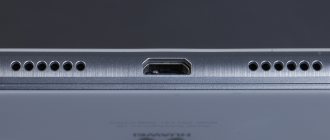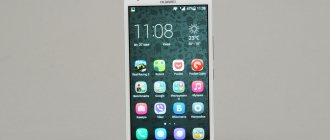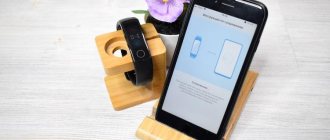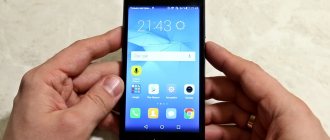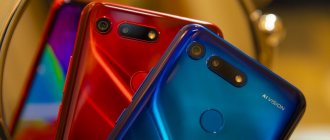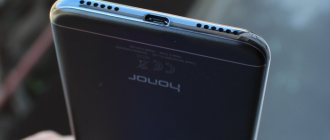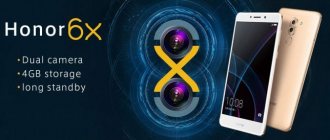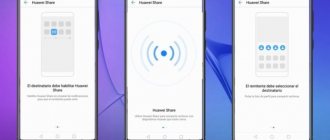I wrote about Huawei’s tactics when creating flagship Honor series smartphones in a preliminary review straight from the event - the company takes its top-end device, presented about six months before the key announcement of the sub-brand, packages it in a new wrapper, slightly (very slightly) changes the characteristics and sells it for a third cheaper. Voila - a ready-made hit! It worked with last year's Honor 8, which grew out of the Huawei P9, and it also works with the Honor 9 - the actual result of a restyling of the Huawei P10.
At the same time, Honor 9 inherits its predecessor in style - the Chinese did not fundamentally change the design, so we are dealing with another shiny gadget that shimmers in the light. Except that a key with a fingerprint scanner appeared on the front panel, the dimensions changed slightly, and the back cover received rounded edges - now, unwittingly, designers will run into comparisons with Xiaomi Mi6. Well, this is the most direct competitor for the new Honor; a head-on collision with it cannot be avoided.
If we ignore the design, then perhaps the only difference from the Huawei P10 that catches the eye is the disappearance of references to Leica as a partner in the development of the camera. At the same time, the camera characteristics themselves remained unchanged: a dual module with an RGB sensor of 13 megapixels and a monochrome sensor of 20. Let's see how well it performs without the (visible) influence of Leica. Well, let's check other capabilities of the smartphone, of course.
Specifications
| Honor 9 | Huawei P10 | Honor 8 | Xiaomi Mi6 | OnePlus3 | |
| Display | 5.15 inches, IPS, 1920 × 1080 pixels, 428 ppi, capacitive multi-touch | 5.1 inches, IPS, 1920 × 1080 pixels, 432 ppi, capacitive multi-touch | 5.2 inches, IPS, 1920 × 1080 pixels, 424 ppi, capacitive multi-touch | 5.15 inches, IPS, 1920 × 1080 pixels, 428 ppi, capacitive multi-touch | 5.5 inches, AMOLED, 1920 × 1080 pixels, 401 ppi, capacitive multi-touch |
| Protective glass | No information | No information | No information | Yes, manufacturer unknown | Corning Gorilla Glass 4 |
| CPU | HiSilicon Kirin 960 (four ARM Cortex-A73 cores, 2.4 GHz + four ARM Cortex-A53 cores, 1.8 GHz) | HiSilicon Kirin 960 (four ARM Cortex-A73 cores, 2.4 GHz + four ARM Cortex-A53 cores, 1.8 GHz) | HiSilicon Kirin 950 (four ARM Cortex-A72 cores, 2.3 GHz; four ARM Cortex-A53 cores, 1.8 GHz) | Qualcomm Snapdragon 835 MSM8996 (quad Kryo cores, 2.45 GHz + quad Kryo cores, 1.9 GHz) | Qualcomm Snapdragon 820 MSM8996 (dual Kryo cores, 2.15 GHz + dual Kryo cores, 1.36 GHz) |
| Graphics controller | ARM Mali-G71 MP8, 850 MHz | ARM Mali-G71 MP8, 850 MHz | Mali-T880 MP4, 900 MHz | Adreno 540, 710 MHz | Adreno 530, 624 MHz |
| RAM | 4 GB (6 GB version available) | 4 GB | 4 GB | 6 GB | 6 GB |
| Flash memory | 64 GB (there is a version with 128 GB) | 32/64 GB | 32/64 GB | 64/128 GB | 64 GB |
| Memory card support | Eat | Eat | Eat | No | No |
| Connectors | USB Type-C, 3.5 mm mini-jack | USB Type-C, 3.5 mm mini-jack | USB Type-C, 3.5 mm mini-jack | USB Type-C | USB Type-C, 3.5 mm mini-jack |
| SIM cards | Two nano-SIMs | Two nano-SIMs | One nano-SIM/two nano-SIM | Two nano-SIMs | Two nano-SIMs |
| Cellular connection 2G | GSM 850/900/1800/1900 MHz | GSM 850/900/1800/1900 MHz | GSM 850/900/1800/1900 MHz | GSM 850/900/1800/1900 MHz | GSM 850/900/1800/1900 MHz |
| Cellular 3G | HSDPA 850/900/1900/2100 | HSDPA 800/850/900/1700/1900/2100 | HSDPA 850/900/1700/1900/2100 | HSDPA 850/900/1900/2100 | HSDPA 850/900/1900/2100 MHz |
| Cellular 4G | LTE Cat. 6 (300/50 Mbit/s): bands 1, 3, 5, 7, 8, 20, 38, 40, 41 | LTE Cat. 12 (600/150 Mbps): bands 1, 2, 3, 4, 5, 6, 7, 8, 9, 12, 17, 18, 19, 20, 26, 28, 38, 39, 40, 41 | LTE Cat. 6 (300/50 Mbit/s): bands 1, 3, 7, 8, 20 | LTE Cat. 16 (1000/150 Mbit/s): bands 1, 3, 5, 7, 8, 38, 39, 40, 41 | LTE Cat. 6 (300/50 Mbit/s): bands 1, 2, 3, 4, 5, 7, 8, 9, 17, 18, 19, 20, 28, 29, 38, 39, 40, 41 |
| WiFi | 802.11a/b/g/n/ac | 802.11a/b/g/n/ac | 802.11a/b/g/n/ac | 802.11a/b/g/n/ac | 802.11a/b/g/n/ac |
| Bluetooth | 4.2 | 4.2 | 4.2 | 5.0 | 4.2 |
| NFC | Eat | Eat | Eat | Eat | Eat |
| Navigation | GPS, A-GPS, GLONASS, BeiDou | GPS, A-GPS, GLONASS, BeiDou, Galileo | GPS, A-GPS, GLONASS | GPS, A-GPS, GLONASS, BeiDou | GPS, A-GPS, GLONASS, BeiDou |
| Sensors | Light, proximity, accelerometer/gyroscope, magnetometer (digital compass), IR sensor | Light, proximity, accelerometer/gyroscope, magnetometer (digital compass), IR sensor | Light, proximity, accelerometer/gyroscope, magnetometer (digital compass), IR sensor | Light, proximity, accelerometer/gyroscope, magnetometer (digital compass), barometer, IR sensor | Illumination, proximity, accelerometer/gyroscope, magnetometer (digital compass) |
| Fingerprint's scanner | Eat | Eat | Eat | Eat | Eat |
| Main camera | Dual module, 20 + 12 MP, ƒ/2.2, hybrid autofocus, dual LED flash | Dual module, 20 + 12 MP, ƒ/2.2, hybrid autofocus, optical stabilization, dual LED flash | Dual module, 12 MP, ƒ/2.2, phase detection autofocus, LED flash | Dual module, 12 MP: 27 mm, ƒ/1.8 + 52 mm, ƒ/2.6 (2x zoom); Optical stabilizer operates at wide angles; phase detection autofocus, dual LED flash | 16 MP, ƒ/2.0, phase detection autofocus, optical stabilization, LED flash |
| Front-camera | 8 MP, ƒ/2.4, fixed focus | 8 MP, ƒ/1.9, fixed focus | 8 MP, fixed focus | 8 MP, fixed focus | 8 MP, fixed focus |
| Nutrition | Non-removable battery 12.16 Wh (3200 mAh, 3.8 V) | Non-removable battery 12.16 Wh (3200 mAh, 3.8 V) | Non-removable 11.4 Wh battery (3000 mAh, 3.8 V) | Non-removable 12.73 Wh battery (3350 mAh, 3.8 V) | Non-removable battery: 11.3 Wh (3000 mAh, 3.8 V) |
| Size | 147.3 × 70.9 × 7.45 mm | 145.3 × 69.3 × 6.98 mm | 145.5 × 71 × 7.5 mm | 145.2 × 70.5 × 7.45 mm | 152.7 × 74.7 × 7.4 mm |
| Weight | 155 grams | 145 grams | 153 grams | 168/182 grams (regular/ceramic version) | 158 grams |
| Housing protection | No | No | No | Splash protection | No |
| operating system | Android 7.0 Nougat, own EMUI shell | Android 7.0 Nougat, own EMUI shell | Android 6.0 Marshmallow, own EMUI shell | Android 7.1.1 Nougat, own MIUI shell | Android 6.0 Marshmallow, OxygenOS shell |
| Current price | 26,990 rubles | 35,990 rubles | 22,000-25,000 rubles | 29,990 rubles | 26,000 rubles |
| Honor 9 – information about the filling according to the CPU-Z application | ||||
⇡#Appearance, ergonomics and software
In the previous flagship device of the family, Honor 8, the designers managed to find a special style, their own unique face for the smartphone - albeit at the cost of the fact that the body was easily scratched and stained. But now, when phones are becoming almost indistinguishable from each other, especially in the mid-range and budget segment (flagships still stand out), the advantages of this approach outweigh the disadvantages. This was directly confirmed by the sales of the G8, and indirectly by the fact that Taiwanese HTC chose a similar approach for its new U series. With the same mirror gloss.
| The most spectacular Honor 9, blue | ||||
Honor 9 is the most direct successor to its ancestor, and this shows in everything. Both the front surface and the back cover are covered with glass, which effectively reflects light - and perfectly collects fingerprints. The sides are still made of metal. In fact, a smartphone looks really great only in photographs, on display, and in the first minutes after unpacking; then it is advisable to hide it in the bumper case that comes with the kit - and relax. But even in this form, Honor 9 retains its individuality.
| Black Honor 9 | ||||
There are three color options: blue, gray and black, and the fourth, gold, is currently sold exclusively in China. Perhaps other versions will appear in the future, albeit in limited editions.
Honor 9, front panel: above the screen there is a speaker with a status indicator built into its grille, a light sensor and a front camera; Below the screen is a Home key with a built-in fingerprint scanner and two backlit touch navigation keys
Honor 9 is slightly larger, thicker and heavier than the Huawei P10, which is unusual for a “younger” model. Typically, older smartphones, on the contrary, look more solid. This was partly due to the display - here its diagonal is 0.05 inches larger (this is not a typo!). Partly due to design arbitrariness, the devices are technically very similar. For example, the capacity of the batteries used in these smartphones is the same: 3200 mAh.
Honor 9, rear panel: two main camera lenses, dual LED flash, laser autofocus assistant
The “nine” is practically no different in size from Honor 8 and its main competitor, Xiaomi Mi6. It is convenient to use with one hand, it hides perfectly in your pocket - this is a convenient device in all respects. Except for one thing - if you ignore the above remark about the bumper case, then Honor 9 will turn out to be a very slippery smartphone that tends to fly out of your hands and go on a fatal date with the floor or pavement. Unfortunately, the device does not have any fall protection. Recently, only special handsets for travelers or Moto Force series smartphones can boast of this. Also, the new product does not have protection from dust and moisture - this is a little more sad, although it is also typical for the “up to 30 thousand rubles” segment.
Honor 9, top edge: IR sensor and microphone
Honor 9, bottom edge: USB Type-C port, another microphone, speaker grille and mini-jack
The layout of the devices is also identical. Below the screen there is a “Home” key with a built-in fingerprint scanner, on either side of it there are touch-sensitive navigation keys (this allows you to save space on a relatively small, by modern standards, display). Physical power and volume keys, interfaces – everything is in its usual place.
Honor 9, left side: slot for SIM cards and/or memory card
Honor 9, right side: power and volume keys
There are no surprises, as Thom Yorke sang - unless the IR port on the top edge may surprise someone, but it came back into use last year and was also included in Honor 8. The camera unit, by the way, does not protrude above body, like its predecessor.
The fingerprint scanner is located in a button on the front panel - on the one hand, hurray, just like in the iPhone. On the other hand, it’s actually less convenient than it was before. The position of our fingers when pressing the button located on the rear panel is much more natural than the one in which we need to touch the front key. The danger of dropping your smartphone increases. However, this is largely a matter of habit.
The scanner is capacitive, works very quickly, but is sensitive to microdamage to the skin of the finger. With it, you can unlock the device, confirm payments (there is NFC and the ability to use Android Pay), control the camera, answer calls and turn off the alarm. It also reacts not only to a simple touch, but also to when the user runs a finger over it - with this movement you can open the notification panel.
Branded shell for Android – EMUI 5.1
View all images (26)
Operating system – Android 7.0 Nougat, covered with EMUI 5.1 shell. There are no “technical” features of the shell here. A special feature of Honor is the greater software integration of the devices into their environment. In particular, Russian Honor 9 out of the box received Yandex search (along with Google), Sberbank application and 2GIS navigation. How valuable it is, decide for yourself.
The shell itself works very quickly and does not cause irritation - Huawei, after a not very successful start with its EMUI, gradually got used to it and is creating an excellent software environment.
Honor and Huawei: tricks and secrets
Modern features of Honor and Huawei phones:
- unlocking with a glance;
- fingerprint application block;
- split screen;
- voice control;
- Eye Comfort to protect your pupils from bright light.
This is not a complete list of Honor's capabilities and features.
Face unlock
One of the most popular recently is the ability to unlock the display with your gaze. Mystic? No, just a regular face recognition scanner on the camera. This is one of the security parameters that can be debugged in the settings. You go to the “Locking and Security” section, select the block type there, and read the facial expression through the front camera.
The requirement is the absence of glasses and other accessories that interfere with recognition, a clear and bright image, and the absence of other people. You take a photo, then, in case the camera breaks, set an additional unlocking method - pin, password, pattern, fingerprint, etc.
Gestures
Gesture control is another modern feature of Huawei. There are two control options here: using a button on the display, or without its help. Gesture control is debugged in the main settings. There you specify what action is caused by waving your hand in front of the screen left, right, up and down.
Why the Huawei Mobile Services application does not work: reasons, how to fix it?
Navigation key
If you choose control using the Home button. You can not only press it, but also swipe it left and right. And each movement configures its own option. Such hidden functions of Honor help make control more convenient and adapt to the person. Because the phone is used by both left- and right-handed people, and they can adjust the presets to suit themselves.
Dock station
This extension allows you to give commands to your phone with one hand. With this setting, the familiar panel loses its classic properties. Control is now available with one-handed movements.
Screen Recording
Another partially hidden feature of Huawei is recording images from the display. You go to the settings folder on your phone, select the camera icon with the inscription “Screen Recording”, a shortcut appears at the bottom - a red black dot. To start fixing, click on it.
After this, a timer appears on the display, which displays long-term recording. It will not be visible when watching the video. In the parameters it is possible to set whether this mode will record sound, and if so, from where - the microphone or the main speaker.
Motion Control
This is an analogue of gesture debugging, only here everything is done without touching the screen - with a wave of the hand. For example, by swiping from left to right, it is possible to turn on the camera. Not all phones have such capabilities, but most do. These options are not included in the older budget versions.
Screenshot
This is one of the most common phone options - screen snapshot. This is done by synchronously pressing the lock key and the volume control button. Automatically saved to a separate folder in the gallery.
Mini screen for one hand
In order to more quickly enable functions and control processes on the screen, it is possible to activate the mini-screen for one hand. This can be activated in the settings. Then the navigation bar splits and a small command screen appears. It can be closed by swiping left.
If you have any questions or complaints, please let us know
Ask a Question
Application clone
This function is relevant for those who have created several accounts. To avoid confusion in accounts, it is possible to create two or three copies of the application, where authorization occurs under a different login and password.
Battery percentage
Percentage display is more convenient than graphical display. Because then it is possible to know exactly how much time is left before turning off, and when the device needs to be charged.
Changing screen resolution
This secret of Honor and Huawei allows you to reduce the quality of photos and videos to save battery power. A lower image resolution is activated in parallel with the activation of the energy saving mode.
Hiding the cutout
Many modern smartphones have a teardrop-shaped camera cutout. It may appear as a status bar separator, or the status bar may appear below it. This is also adjustable in the screen settings.
Full screen mode
To make the screen frames thin and invisible, you can switch to a wide aspect ratio. This tool is suitable for those who often watch videos or play a lot on a gadget. Then both visually and actually the field for the image becomes larger.
Home screen style
This is the field where frequently used applications are displayed - instant messengers, camera, call log, browser and others. In order not to look for these icons among dozens of others in the main menu, you can simply place them on the main screen space. Its style and icon design is regulated in the “Themes” section.
Changing the font style
Android provides users with small, medium and large fonts. You can change the text parameters in the “Screen” section, “Text style” sub-item.
Personal space
It's like a second phone interface. The tool is widely used among people who often give their phone to children. Private Space contains individual components and software that are available for viewing by children. You can activate “Personal Space” in the accessibility section of your smartphone.
Voice control
When setting up personal settings for a mobile device, your Google account provides the ability to use a voice assistant. It turns on after long pressing the Home button. Next, the owner pronounces a command, for example, “OK, Google, call Alexander.” And the smart device dials the person who is signed in the phone book as “Alexander”. It is convenient and safe, because the system recognizes only your voice.
Energy Saving
No matter how energy-intensive a gadget is, it still runs out of charge. Some processes speed up the charge reduction, while others save the battery. Modern phones have a fairly popular parameter - energy saving. You can enable it in the “Battery and Performance” section. Activating the mode will extend the battery life of the phone.
How to disable Talkback on Huawei and Honor - 3 ways
Eye protection
Every day we spend a large amount of our free time looking at our phones, laptops or PCs. This causes your eyes to get tired and your concentration to decrease. To protect the pupil and lens from the harmful effects of bright waves, there is an Eye Comfort tool. It is designed to reduce the screen brightness during use.
Turning on and off by timer
This is another feature that allows you to save battery power. The owner specifies the time when the phone turns off. For example, at night.
Split Screen
Another useful feature that modern smartphones have. It allows you to open the taskbar and drag a window through it to a second space. The screen is then automatically divided into two active fields. On one you can actually watch videos, and on the other you can type messages. It is very comfortable.
Quick Shot
Through the camera settings it is possible to set a task to quickly call the camera interface. Double-clicking the volume control takes a photo.
⇡#Display and sound
Huawei reserves high-resolution AMOLED matrices for special versions of its smartphones (like the P10 Plus or the Mate 9 Porsche Design, which is not sold in Russia). Nothing surprises about Honor 9: IPS (LPTS) with a diagonal of 5.15 inches and a resolution of 1920 × 1080 pixels. It must be admitted that the balance of size and resolution is maintained very well - it is impossible to discern any “roughness” in the picture; for about five-inch displays, Full HD is more than enough. Pixel density – 423 ppi. Not the limit, of course, but let me remind you that the Retina standard, for example, provides for a density of 300-320 ppi.
In this case, the unexpected problem of the P10 with an oleophobic coating was avoided - Honor 9 “fights” fingerprints and some traces very well, and it’s quite easy to erase them from the screen. The viewing angles are free - when you deviate your gaze, the contrast drops, but the colors are not distorted. You can (with moderate comfort) use your smartphone with gloves - to do this, you need to enable a special mode in the settings.
In the sun the screen behaves normally, but not brilliantly. The maximum brightness measured instrumentally is 449 cd/m2. This is a standard indicator for Huawei smartphones, but in comparison with what the ever-memorable Xiaomi Mi6 produces, it looks weak. This is confirmed by the sensations of the work: seeing something on the gadget’s display under the sun, of course, is not a problem, but the picture fades and turns gray.
The contrast is also average – 1211:1. The minimum luminosity of the black field is 0.3 cd/m2. Quite normal indicators for a modern IPS display used in a mobile device. For real black, you need to go to OLED panels. But the Chinese managed to avoid failure.
Honor 9, gamma. Yellow line – Honor indicators, dotted line – reference range
Honor 9, color temperature. Blue line – Honor indicators, dotted line – reference temperature
The display is set up relatively well. The average gamma is 2.30, the behavior of the curves can be seen in the graph above. The default color temperature, of course, is higher than normal - it ranges from 8000 to 9500 K (mostly around 8500 K) - it is generally accepted that users love cool shades, even if the picture looks completely different from what the author intended. But if you wish, you can adjust the temperature to suit your needs - this option is in the settings.
Honor 9, color gamut. Gray triangle – sRGB coverage, white triangle – Honor coverage
The absence of real problems with the factory screen settings is confirmed by the color rendering test: the average deviation DeltaE for the extended Color Checker palette (shades of gray + a wide range of color shades) is 5.07 - noticeably worse than the reference values, but slightly better than the average for modern smartphones.
| Honor 9, display settings | ||||
You won’t find an audiophile DAC or amplifier inside the Honor 9; the smartphone should bring special joy to a music lover exclusively through software methods: the company boasts of the proprietary Honor Purity equalizer and the proprietary Huawei Histen virtual sound volume technology. They, of course, don’t turn the experience of smartphone sound upside down, but at least they don’t spoil the picture. The sound is tasty, quite powerful (there is no need to turn the volume up to maximum when using a smartphone in public transport), the detail is good, there is no frequency imbalance. It’s nice to listen to music of any genre on the Honor 9, but I wouldn’t replace it with an audiophile player.
There is one built-in speaker. It is quite loud, I had no problems hearing the smartphone in the next room or in my pocket. But you can’t entrust him with sound support at a house party. The microphones, as well as the speaker, are good - I had no problems hearing my interlocutors, and no one complained on the other end of the line.
conclusions
Summarizing our review of the Honor 9 smartphone, we can once again praise Huawei for a good new product. Qualitative differences from the predecessor of the line are noticeable, and although Xiaomi with its sixth flagship is still ahead in terms of hardware, there are several reasons to prefer Honor 9 when choosing between models. First of all, the point is an improved camera, and, of course, a more affordable price. Let's not forget that Mi 6 is a flagship, and Honor 9 is only a representative of the mid-price segment. To get a more complete picture of the gadget, we recommend watching its video review.
⇡#Hardware and performance
Honor 9 uses Huawei's main platform of 2020 - Kirin 960. It debuted in January's Mate 9 and was the first in the world to receive ARM Cortex-A73 cores made using a 10nm process technology. There are four of them used in the system, the clock frequency is limited to 2.4 GHz - four ARM Cortex-A53 with a clock frequency of 1.8 GHz work together with them. The Mali-G71 accelerator with a clock frequency of 850 MHz is responsible for the graphics.
As is the case with Huawei, at the beginning of the year the company releases a system-on-a-chip, which rightfully receives the title of “the most productive on the market” - they can be trumped for several months, until the moment when smartphones with the flagship platforms of Samsung and Qualcomm appear - they Senior Kirin naturally loses, but saves face. If you compare head-to-head with the Samsung Galaxy S8, the lag will be noticeable. If you look at other smartphones priced up to 30 thousand rubles, then Honor 9 looks at least confident (next to Xiaomi Mi6 with its Snapdragon 835), and at most wonderful (next to all other competitors).
Together with the platform, Honor 9 received 4 GB of RAM – more than enough to work with a Full HD display, both at the time of the smartphone’s release and with a reserve for several years in the future. Nevertheless, a six-gigabyte version also exists, although it is not officially sold in Russia (at least not yet). This is another funny difference from the nominally older model, Huawei P10: for it 4 GB is the limit, and non-volatile memory is offered with a choice of 32 or 64 GB. For Honor 9, the basic version includes 64 GB of flash memory, and the “extended” version – as much as 128 GB.
The performance of Honor 9 is enough for the system to work extremely smoothly with basic functions, without experiencing any problems with the browser and basic applications, and even to run the most demanding modern games. Maybe the Huawei platform will not provide such a reserve as the Snapdragon 835 offers, but today there is definitely nothing to complain about. The problem with the Kirin 960 is not performance, but energy efficiency, but more on that below.
Honor 9 has a slot for a microSD memory card (with a capacity of up to 256 GB) - to use it, as always, you will have to sacrifice one of the two SIM cards.
⇡#Communications and wireless communications
Honor 9 habitually boasts of two slots for nano-SIM cards, but the company just as usual clarifies that they work alternately - there is only one radio module. One of the differences between the “nine” and the Huawei P10 is the lower class of the LTE module. Despite the very similar filling, the modem allows you to work in networks no higher than category six (peak data transfer speed is 300 Mbit/s), while Huawei P10 can transfer data at speeds of up to 600 Mbit/s (Cat. 12). All frequencies necessary for normal operation in Russia are supported, although the general list of bands is noticeably shorter than that of the P10.
Honor 9, slot for SIM cards and memory card
There is a full set of wireless modules: NFC with support for virtual payment, Bluetooth 4.2 LE, dual-band Wi-Fi 802.11a/b/g/n/ac and the already mentioned IR port (in addition to which, of course, the application is also installed on the smartphone to control various third-party equipment).
| Honor 9, AndroiTS GPS Test results | ||||
The navigation module works with GPS (including A-GPS), GLONASS, Galileo, BeiDou. The module works confidently - it finds up to 20 satellites in about 10 seconds, and it takes another 10 seconds to navigate them with an accuracy of 4-6 meters.
Honor 9 review: technical specifications
- Operating system: Android 7 with EMUI shell
- Screen: IPS, 5.15 inches, 1920x1080 pixels
- Processor: eight-core HiSilicon Kirin 960 (4 ARM Cortex-A73 cores at 2.4 GHz + 4 ARM Cortex-A53 at 1.8 GHz)
- Graphics: Mali-G71 MP8
- RAM: 4/6 GB
- Built-in memory: 64/128 GB + slot for micro SD up to 256 GB
- Main camera: 20 MP + 12 MP, f/2.2
- Front camera: 8 MP
- Mobile communications: two nanoSIM, LTE
- Wireless interfaces: Wi-Fi a/b/g/n/ac, Bluetooth 4.2 LE, NFC
- FM radio: no
- IR port: yes
- Headphone Jack: 3.5mm
- Battery: 3200 mAh, fast charging via USB Type-C
- Dimensions: 147.3 x 70.9 x 7.5 mm
- Weight: 155 grams
- Price: 26,990 rubles
Let us remind you that Honor is like “Huawei, but cheaper”, for the young and strong-willed, the brand’s slogan is “For the brave”. Does this mean that a user of Honor smartphones must have some kind of exceptional stress resistance? The manufacturer does not provide an answer. In China, they believe that smartphones worthy of bearing the name of the company itself - Huawei - should cost more. The price increase is justified by “expensive” marketing, a more solid design and the involvement of “wedding generals” called upon to attest to the uniqueness of the devices, such as the manufacturer of ultra-expensive cameras Leica or the Pantone Color Institute. Understand correctly, the flagship P10 (and especially the slightly less compact P10 Plus) are also excellent smartphones at a price significantly lower than market leaders with similar capabilities. But the inside of Honor 9 is the same, flagship. And the price is simply excellent, at the level of the iPhone before last year.
⇡#Camera
The Leica logo, along with proprietary fonts, does not appear in the application in Honor - this is the privilege of smartphones sold under the “parent” brand Huawei. This does not prevent the Chinese company from equipping them with exactly the same modules - at least in terms of characteristics they are identical. The Honor 9 uses a dual camera system, which we first saw in the Mate 9: a 12-megapixel RGB sensor is accompanied by a 20-megapixel monochrome sensor. The optics do not say SUMMARIT, but at least the aperture is the same: ƒ/2.2.
And the manufacturers did not radically reduce the software capabilities of the camera. If Honor 8, for example, did not have a monochrome mode, then Honor 9 quite has it. Along with it, a “professional” mode is also available with the ability to enter manual settings and shoot in RAW format, the usual software background blur with aperture simulation up to ƒ/0.95 (which was once the key feature of the company’s first dual-camera smartphone, Honor 6 Plus), software stitching of HDR, panoramas and so on. No, in fact, only simulations of Leica films, but I wouldn’t say that this is a huge loss.
| Honor 9, camera app interface | ||||
The logic of the interface remains unchanged - and this is good, the camera in the latest versions of EMUI is very convenient to use.
Photo taken in portrait mode
But to say that this is the same camera as in the P10 and Mate 9 would still be incorrect. First, the good news - Honor 9 has a couple of its own software tricks. There is an analogue of Live Photos named after Apple, which can also be activated and forgotten - just mini-videos will be recorded by default. I’d also like to note the portrait mode: it combines software background blur and various picture “enhancement” effects - smoothing and changing skin tone, easy correction of the oval of the face, and so on. Everything can be customized.
And now the bad news - the optical stabilizer remains the privilege of older models, and this is the only real drawback of Honor 9 relative to both its more expensive colleagues and some competitors. It’s not clear what made Huawei abandon it in the “nine” - there were hardly any design restrictions (the case here is even thicker than in the P10, let me remind you), so we can only blame marketing. It’s very in vain, what else can be said here - the abilities of a camera that is excellent in many respects are significantly reduced when shooting in insufficient lighting. Yes, proprietary technology combining images from a monochrome sensor and an RGB matrix allows you to count on a relatively low noise level and acceptable detail, but it is no longer possible to shoot at long shutter speeds, and this seriously affects the Honor 9 camera.
| Two examples of shooting on Honor 9 using 2x zoom - in normal lighting and in the dark | ||||
Otherwise, everything is quite expected: the dynamic range is excellent for a mobile camera, and detail and color rendition, for my taste, have even improved slightly compared to what was in the P10 - the developers are not eating their bread in vain. There is also a 2x zoom using supersampling: the camera uses information from a 20-megapixel monochrome sensor to create (more precisely, “invent” by duplicating pixels) an image of even higher resolution, and then cuts out the required piece from it with a resolution of 3968 × 2976. This is a zoom It works great in normal lighting, but in difficult light conditions there is a noticeable drop in detail, plus problems with color rendering appear.
Honor 9
View all images (26)Even despite the lack of an optical stabilizer, Honor 9 has, if not definitely the best, then one of the best cameras in its class. 4K video shooting is available, of course.
The front camera is also slightly cropped compared to the P10. The sensor is the same, 8 megapixels, but the lens aperture is ƒ/2.4, while the P10 has ƒ/1.9. The difference is not critical, but it’s clear who will take better selfies in the dark. There is no autofocus or flash for the front camera. But there is software background blur - in fact, the work of the selfie camera in this case duplicates the portrait mode for the main one, adjusted for a different angle of view.
⇡#Autonomous work
Huawei P10 turned out to be a nice smartphone, but with one very noticeable drawback - short battery life. Alas, in Honor 9, along with a bunch of advantages of this device, this disadvantage has also passed on. It would seem a relatively small display with a relatively modest resolution for our times - and a 12.16 Wh battery (3200 mAh, 3.8 V). Great, why worry?
But there is a reason, unfortunately. The Kirin 960 platform is very power-hungry, and the LCD display is not AMOLED, so the battery is guaranteed to be “eaten up” within a day even under moderate loads. If the device is heavily loaded, it may well not last even a working day (9-10 hours), so immediately prepare an external battery. In our traditional test with HD video playback at maximum brightness, with Wi-Fi turned on and auto-update, the smartphone lasted just over seven and a half hours. This is a good indicator, so you can count on Honor 9 as a video player, but it copes worse with complex loads.
Honor 9 is charged using the USB Type-C port, and Huawei Supercharge technology is supported, which allows you to charge the smartphone by about half in half an hour. To do this, you need to use a charger with a current of 2A - preferably a branded one. The Honor 9 takes a little over an hour to fully charge with its charger.
Equipment and appearance
The style of Honor 9 is taken into account even in the box of the device. The smartphone comes in a white oblong package with the number 9 on the front side. The device itself, a charging unit, a USB Type-C cable, documentation and a silicone bumper are hidden inside.
The latter will be especially useful in everyday use, since the shiny body of the Honor 9 quickly loses its original appearance after a couple of scratches. The surface will also make its owner nervous more than once; the glass of the rear panel often tries to slip out of hands. Nevertheless, the smartphone cannot be called inconvenient - on the contrary, since the matte metal on the rounded edges “clings” well.
In general, Honor 9 definitely succeeded in everything related to tactile sensations. The front 2.5D glass of the device has an oleophobic coating that does not accumulate stains and fingerprints. Externally, the smartphone also leaves behind most of its competitors. The shine of the back cover will definitely attract the attention of others in bright light. The device is available in grey, black and blue color options. The silver version can only be found in the Chinese market.
A fingerprint scanner is located under the 5.15-inch display. This model also got rid of the keys on the screen; now they are replaced by two touch pads on the sides of the scanner. Their functions can be set in the smartphone settings.
At the top of the front panel there is a front-facing 8-megapixel camera, an earpiece and a set of sensors. The Honor 9 does not have an LED notification indicator.
On the right is the volume key and the smartphone activation button. A thin plastic antenna insert is visible just above.
A small section of the left side is reserved for a compartment with two SIM cards. One of them can be replaced with microSD up to 256 GB. A multimedia speaker is hidden under the perforation on the bottom end of the smartphone. To the right of it is a USB Type-C connector and a 3.5 mm headphone jack. There are two small holes at the top. Under one of them there is a built-in microphone, the second is intended for an infrared port, with which you can control digital equipment.
At the back is a dual main camera module. To the right of the lenses you can see a small protrusion with a dual LED flash. The back panel reflects light according to the principle of ray scattering, so that in bright light the smartphone shimmers in different shades of its color.
Overall, Honor 9 has the potential to be one of the most beautiful mobile devices on the market. It doesn't have a metal unibody body, but the tempered glass on both sides gives it that same premium smartphone feel. The device is also equipped with a screen with a very convenient diagonal for one-handed use. However, if you want to preserve the appearance of the device longer, it is still recommended to “dress” it with a silicone bumper.
